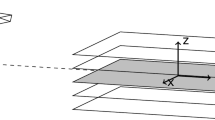Abstract
Prediction errors are commonly used when analyzing the performance of a multi-camera stereo system using at least three cameras. This paper discusses this methodology for performance evaluation for the first time on long stereo sequences (in the context of vision-based driver assistance systems). Three cameras are calibrated in an ego-vehicle, and prediction error analysis is performed on recorded stereo sequences. They are evaluated using various common stereo matching algorithms, such as belief propagation, dynamic programming, semi-global matching, or graph cut. Performance is evaluated on both synthetic and real data.
Preview
Unable to display preview. Download preview PDF.
Similar content being viewed by others
References
Baker, S., Scharstein, S., Lewis, J.P., Roth, S., Black, M.J., Szelisky, R.: A database and evaluation methodology for optical flow. In: Proc. IEEE Int. Conf. Computer Vision, CD (2007)
Boykov, Y., Veksler, O., Zabih, R.: Fast approximate energy minimization via graph cuts. IEEE Trans. Pattern Analysis Machine Intelligence 23, 1222–1239 (2001)
.enpeda.. image sequence analysis test site (EISATS), http://www.mi.auckland.ac.nz/EISATS/
Felzenszwalb, P.F., Huttenlocher, D.P.: Efficient belief propagation for early vision. Int. J. Computer Vision 70, 261–268 (2006)
Guan, S., Klette, R., Woo, Y.W.: Belief propagation for stereo analysis of night-vision sequences. In: Wada, T., Huang, F., Lin, S. (eds.) PSIVT 2009. LNCS, vol. 5414, pp. 932–943. Springer, Heidelberg (2009)
Hartley, R., Zisserman, A.: Multiple View Geometry in Computer Vision, 2nd edn. Cambridge University Press, Cambridge (2004)
Hirschmüller, H.: Accurate and efficient stereo processing by semi-global matching and mutual information. In: Proc. Computer Vision Pattern Recognition, vol. 2, pp. 807–814 (2005)
Klette, R., Zamperoni, P.: Handbook of Image Processing Operators. Wiley, Chichester (1996)
Klette, R., Schlüns, K., Koschan, A.: Computer Vision. Three-Dimensional Data from Images. Springer, Singapore (1998)
Kolmogorov, V., Zabih, R.: What energy functions can be minimized via graph cuts? IEEE Trans. Pattern Analysis Machine Intelligence 26, 65–81 (2004)
Liu, Z., Klette, R.: Dynamic programming stereo on real-world sequences. In: Proc. ICONIP. LNCS. Springer, Heidelberg (to appear, 2009)
Morales, S., Vaudrey, T., Klette, R.: An in depth robustness evaluation of stereo algorithms on long stereo sequences. In: Proc. Intelligent Vehicles (to appear, 2009)
Ohta, Y., Kanade, T.: Stereo by two-level dynamic programming. In: Proc. IJCAI, pp. 1120–1126 (1985)
Scharstein, D., Szeliski, R.: A taxonomy and evaluation of dense two-frame stereo correspondence algorithms. Int. J. Computer Vision 47, 7–42 (2002)
Szeliski, R.: Prediction error as a quality metric for motion and stereo. In: Proc. Int. Conf. Computer Vision, vol. 2, pp. 781–788 (1999)
Vaudrey, T., Rabe, C., Klette, R., Milburn, J.: Differences between stereo and motion behavior on synthetic and real-world stereo sequences. In: Proc. Image Vision Computing New Zealand. IEEE, Los Alamitos (2008)
Author information
Authors and Affiliations
Editor information
Editors and Affiliations
Rights and permissions
Copyright information
© 2009 Springer-Verlag Berlin Heidelberg
About this paper
Cite this paper
Morales, S., Klette, R. (2009). A Third Eye for Performance Evaluation in Stereo Sequence Analysis. In: Jiang, X., Petkov, N. (eds) Computer Analysis of Images and Patterns. CAIP 2009. Lecture Notes in Computer Science, vol 5702. Springer, Berlin, Heidelberg. https://doi.org/10.1007/978-3-642-03767-2_131
Download citation
DOI: https://doi.org/10.1007/978-3-642-03767-2_131
Publisher Name: Springer, Berlin, Heidelberg
Print ISBN: 978-3-642-03766-5
Online ISBN: 978-3-642-03767-2
eBook Packages: Computer ScienceComputer Science (R0)




